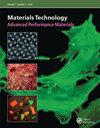Pregelatinized starch as a cohesion promoter improves mechanical property and surgical performance of calcium phosphate bone cement: the effect of starch type
IF 3.7
4区 材料科学
Q3 MATERIALS SCIENCE, MULTIDISCIPLINARY
引用次数: 1
Abstract
ABSTRACT Calcium phosphate cement (CPC) has potentials in orthopaedics and orthodontics but it has significant limitations such as low mechanical strength, low injectability and instability in body. Starches from five botanical sources were used as cohesion additives to prepare calcium phosphate bone cement (CPB) and the starch source showed significant impact on physicochemical properties of the CPBs. CPB modified by pregelatinised waxy maize starch (CPB-W) had the highest mechanical strength, longest setting time, and most compact structure compared with other CPBs. As the amylose content increased, the viscosity of starch modified cement paste increased, and the cured cement had lower density and mechanical strength. It appears that starch with a low amylose content significantly improves the surgical performance and mechanical strength of CPC. CPB-W also exhibited good cytocompatibility to MC3T3-E1 cells. Starch modified CPBs are considered as promising injectable bone cements for minimally invasive surgery applications like vertebroplasty and kyphoplasty.预糊化淀粉作为内聚促进剂改善磷酸钙骨水泥的力学性能和手术性能:淀粉类型的影响
磷酸钙骨水泥(CPC)在骨科和正畸学中具有很大的应用潜力,但存在机械强度低、注射性差、体内不稳定等明显的局限性。以5种植物源淀粉为内聚剂制备磷酸钙骨水泥(CPB),淀粉源对CPB的理化性能有显著影响。预糊化糯玉米淀粉(CPB- w)改性的CPB具有机械强度最高、凝结时间最长、结构最致密的特点。随着直链淀粉含量的增加,淀粉改性水泥浆体的粘度增加,固化水泥的密度和机械强度降低。结果表明,低直链淀粉含量的淀粉可以显著提高CPC的手术性能和机械强度。CPB-W对MC3T3-E1细胞也表现出良好的细胞相容性。淀粉改性CPBs被认为是一种很有前途的可注射骨水泥,可用于微创手术,如椎体成形术和后凸成形术。
本文章由计算机程序翻译,如有差异,请以英文原文为准。
求助全文
约1分钟内获得全文
求助全文
来源期刊

Materials Technology
工程技术-材料科学:综合
CiteScore
6.00
自引率
9.70%
发文量
105
审稿时长
8.7 months
期刊介绍:
Materials Technology: Advanced Performance Materials provides an international medium for the communication of progress in the field of functional materials (advanced materials in which composition, structure and surface are functionalised to confer specific, applications-oriented properties). The focus is on materials for biomedical, electronic, photonic and energy applications. Contributions should address the physical, chemical, or engineering sciences that underpin the design and application of these materials. The scientific and engineering aspects may include processing and structural characterisation from the micro- to nanoscale to achieve specific functionality.
 求助内容:
求助内容: 应助结果提醒方式:
应助结果提醒方式:


